E-Business Application: Management and Operations at Aldi Supermarket
VerifiedAdded on 2023/06/03
|13
|2554
|484
Report
AI Summary
This report examines the e-business application of Aldi Supermarket, analyzing its current operations and strategies within the Australian retail market. It begins with a brief overview of Aldi's business model, focusing on its approach to providing high-quality products at lower prices through exclusively branded products and limited product ranges. The report then delves into an analysis of industry trends, referencing academic research to discuss the impact of data analytics, global market changes, and the role of internet technologies in shaping the future of retail. It provides recommendations for enhancing customer acquisition, improving customer experience, and reducing costs through the use of internet technologies such as data analytics, personalized offers, and RFID sensors. The report concludes with a positive outlook for the retail sector, acknowledging the importance of adapting to the changing landscape of consumer behavior and the increasing influence of online platforms.
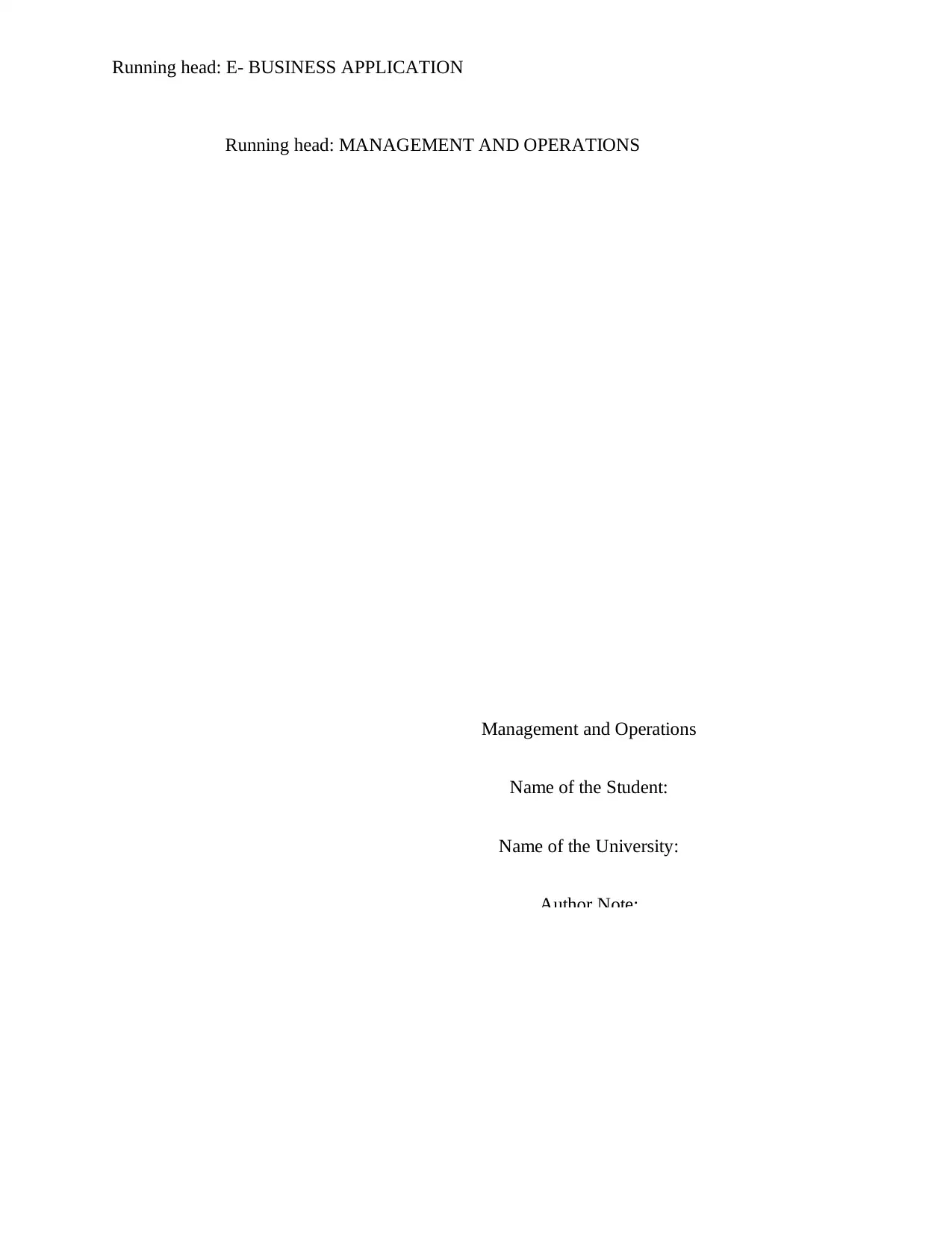
Running head: E- BUSINESS APPLICATION
Running head: MANAGEMENT AND OPERATIONS
Management and Operations
Name of the Student:
Name of the University:
Author Note:
Running head: MANAGEMENT AND OPERATIONS
Management and Operations
Name of the Student:
Name of the University:
Author Note:
Paraphrase This Document
Need a fresh take? Get an instant paraphrase of this document with our AI Paraphraser
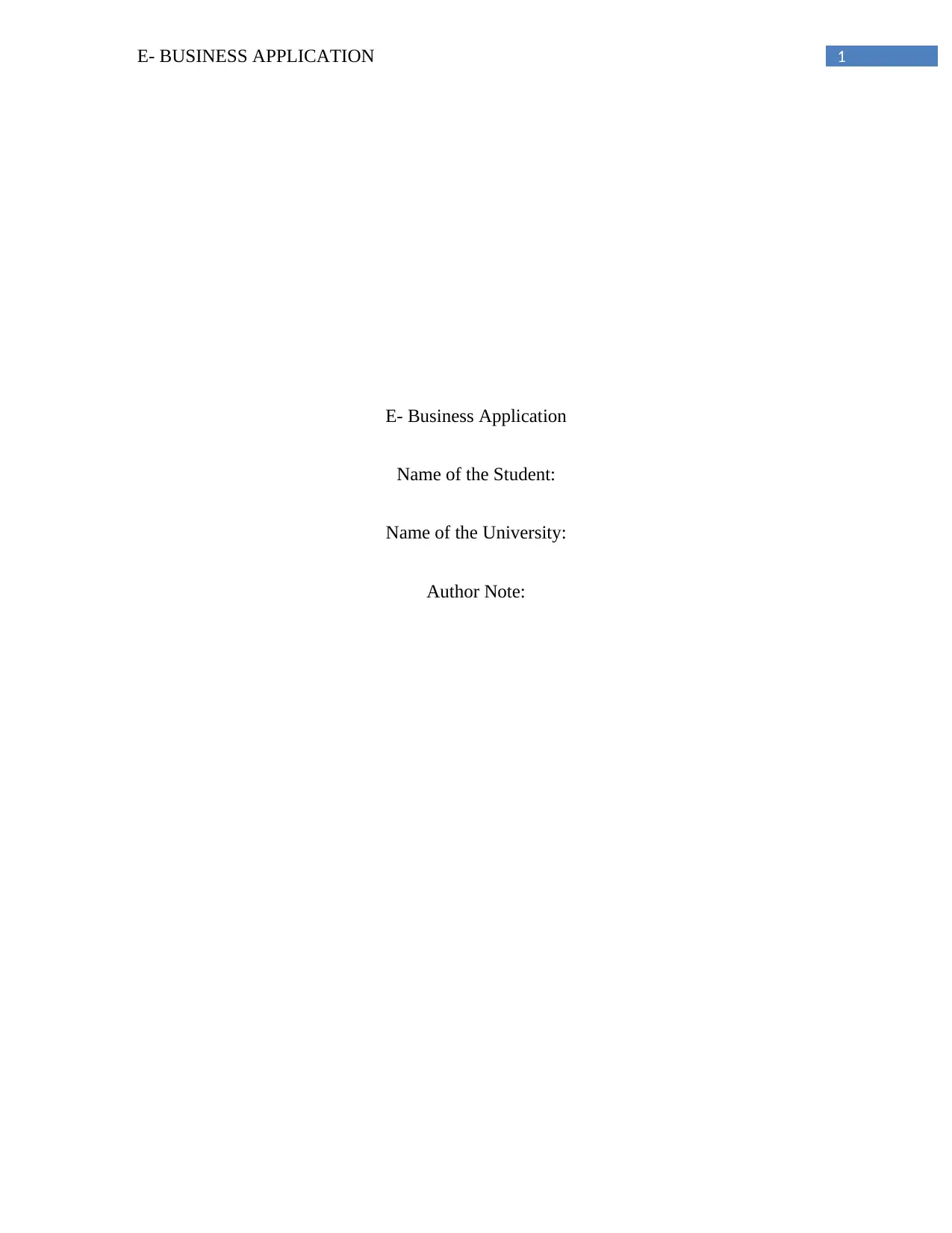
1E- BUSINESS APPLICATION
E- Business Application
Name of the Student:
Name of the University:
Author Note:
E- Business Application
Name of the Student:
Name of the University:
Author Note:
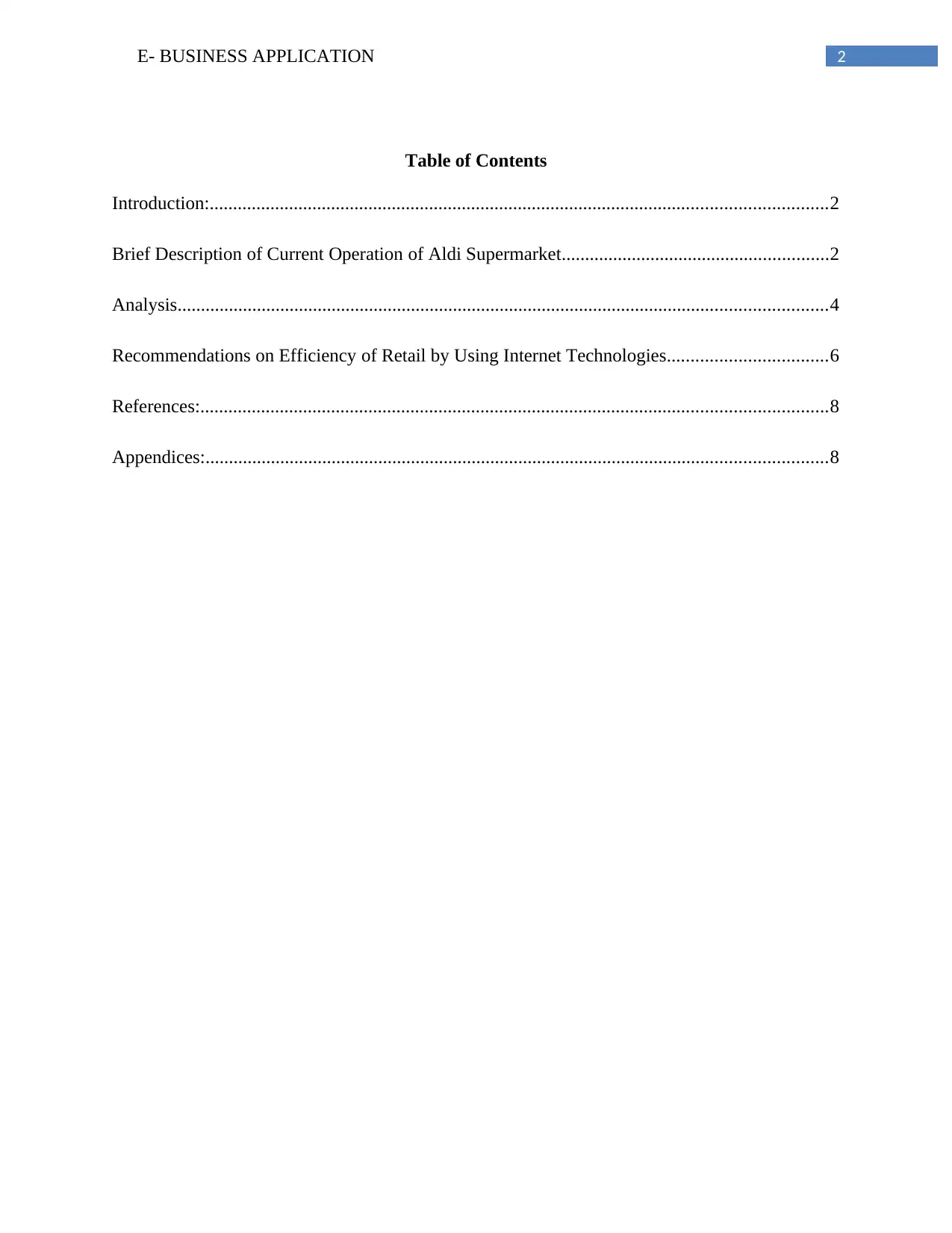
2E- BUSINESS APPLICATION
Table of Contents
Introduction:....................................................................................................................................2
Brief Description of Current Operation of Aldi Supermarket.........................................................2
Analysis...........................................................................................................................................4
Recommendations on Efficiency of Retail by Using Internet Technologies..................................6
References:......................................................................................................................................8
Appendices:.....................................................................................................................................8
Table of Contents
Introduction:....................................................................................................................................2
Brief Description of Current Operation of Aldi Supermarket.........................................................2
Analysis...........................................................................................................................................4
Recommendations on Efficiency of Retail by Using Internet Technologies..................................6
References:......................................................................................................................................8
Appendices:.....................................................................................................................................8
⊘ This is a preview!⊘
Do you want full access?
Subscribe today to unlock all pages.

Trusted by 1+ million students worldwide
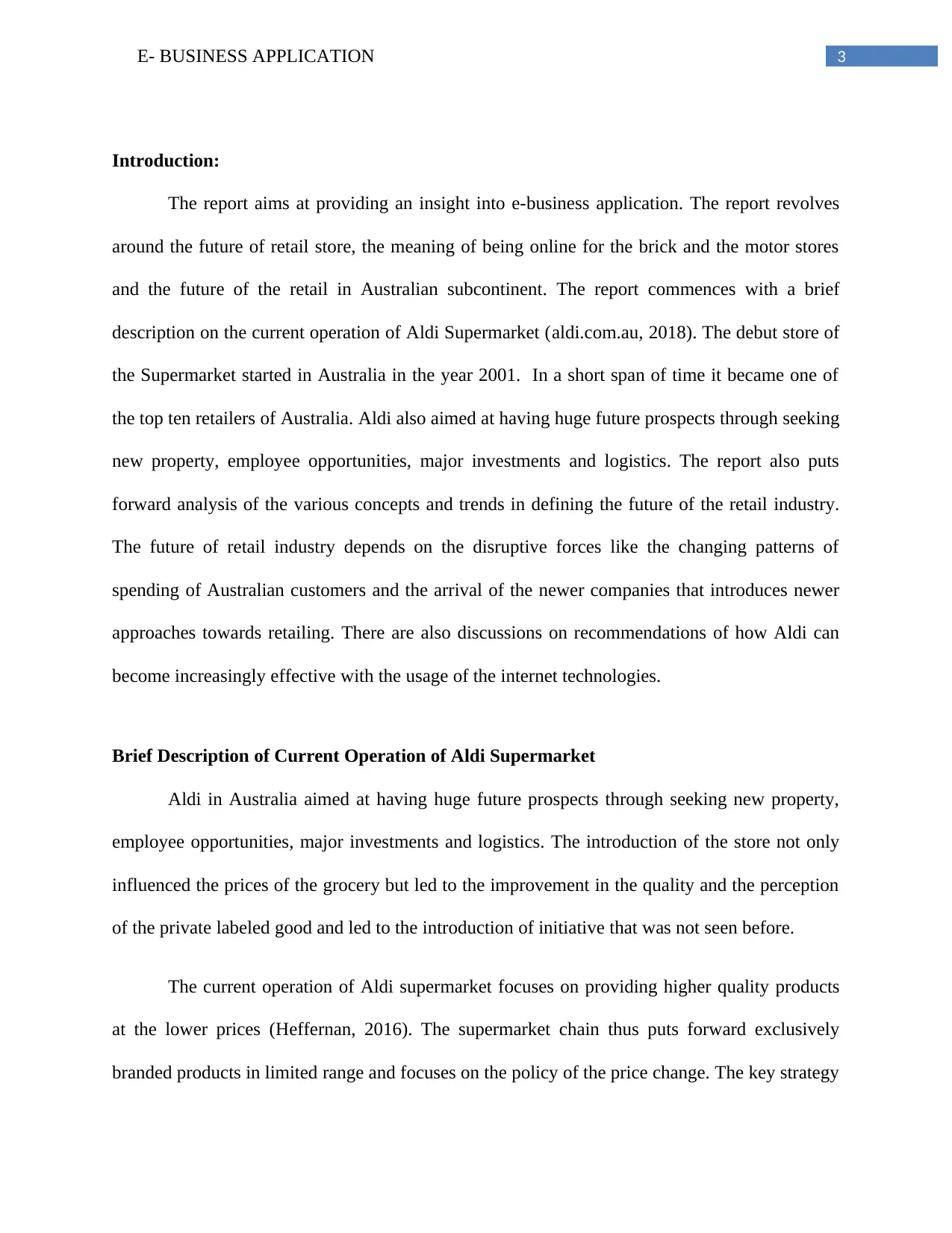
3E- BUSINESS APPLICATION
Introduction:
The report aims at providing an insight into e-business application. The report revolves
around the future of retail store, the meaning of being online for the brick and the motor stores
and the future of the retail in Australian subcontinent. The report commences with a brief
description on the current operation of Aldi Supermarket (aldi.com.au, 2018). The debut store of
the Supermarket started in Australia in the year 2001. In a short span of time it became one of
the top ten retailers of Australia. Aldi also aimed at having huge future prospects through seeking
new property, employee opportunities, major investments and logistics. The report also puts
forward analysis of the various concepts and trends in defining the future of the retail industry.
The future of retail industry depends on the disruptive forces like the changing patterns of
spending of Australian customers and the arrival of the newer companies that introduces newer
approaches towards retailing. There are also discussions on recommendations of how Aldi can
become increasingly effective with the usage of the internet technologies.
Brief Description of Current Operation of Aldi Supermarket
Aldi in Australia aimed at having huge future prospects through seeking new property,
employee opportunities, major investments and logistics. The introduction of the store not only
influenced the prices of the grocery but led to the improvement in the quality and the perception
of the private labeled good and led to the introduction of initiative that was not seen before.
The current operation of Aldi supermarket focuses on providing higher quality products
at the lower prices (Heffernan, 2016). The supermarket chain thus puts forward exclusively
branded products in limited range and focuses on the policy of the price change. The key strategy
Introduction:
The report aims at providing an insight into e-business application. The report revolves
around the future of retail store, the meaning of being online for the brick and the motor stores
and the future of the retail in Australian subcontinent. The report commences with a brief
description on the current operation of Aldi Supermarket (aldi.com.au, 2018). The debut store of
the Supermarket started in Australia in the year 2001. In a short span of time it became one of
the top ten retailers of Australia. Aldi also aimed at having huge future prospects through seeking
new property, employee opportunities, major investments and logistics. The report also puts
forward analysis of the various concepts and trends in defining the future of the retail industry.
The future of retail industry depends on the disruptive forces like the changing patterns of
spending of Australian customers and the arrival of the newer companies that introduces newer
approaches towards retailing. There are also discussions on recommendations of how Aldi can
become increasingly effective with the usage of the internet technologies.
Brief Description of Current Operation of Aldi Supermarket
Aldi in Australia aimed at having huge future prospects through seeking new property,
employee opportunities, major investments and logistics. The introduction of the store not only
influenced the prices of the grocery but led to the improvement in the quality and the perception
of the private labeled good and led to the introduction of initiative that was not seen before.
The current operation of Aldi supermarket focuses on providing higher quality products
at the lower prices (Heffernan, 2016). The supermarket chain thus puts forward exclusively
branded products in limited range and focuses on the policy of the price change. The key strategy
Paraphrase This Document
Need a fresh take? Get an instant paraphrase of this document with our AI Paraphraser
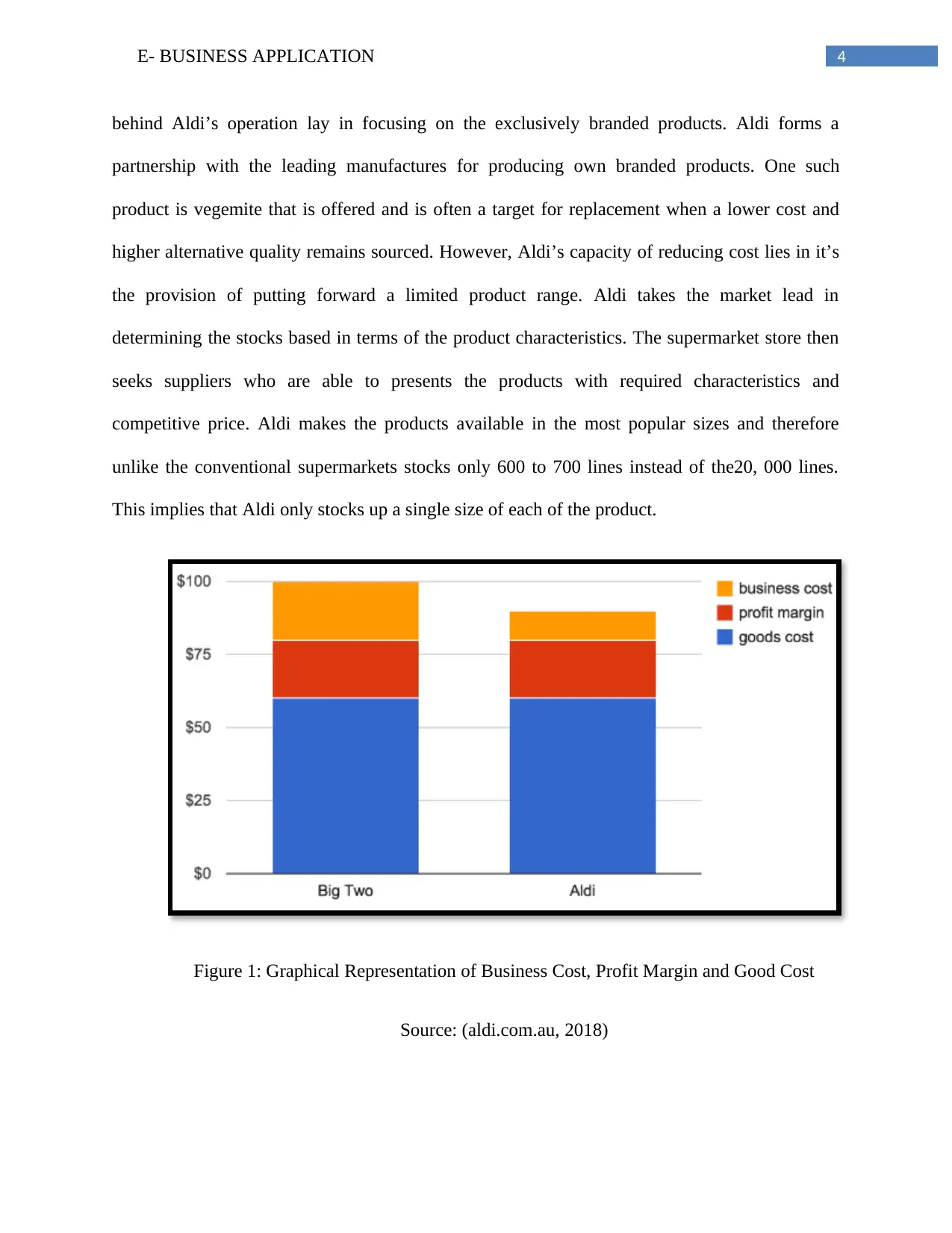
4E- BUSINESS APPLICATION
behind Aldi’s operation lay in focusing on the exclusively branded products. Aldi forms a
partnership with the leading manufactures for producing own branded products. One such
product is vegemite that is offered and is often a target for replacement when a lower cost and
higher alternative quality remains sourced. However, Aldi’s capacity of reducing cost lies in it’s
the provision of putting forward a limited product range. Aldi takes the market lead in
determining the stocks based in terms of the product characteristics. The supermarket store then
seeks suppliers who are able to presents the products with required characteristics and
competitive price. Aldi makes the products available in the most popular sizes and therefore
unlike the conventional supermarkets stocks only 600 to 700 lines instead of the20, 000 lines.
This implies that Aldi only stocks up a single size of each of the product.
Figure 1: Graphical Representation of Business Cost, Profit Margin and Good Cost
Source: (aldi.com.au, 2018)
behind Aldi’s operation lay in focusing on the exclusively branded products. Aldi forms a
partnership with the leading manufactures for producing own branded products. One such
product is vegemite that is offered and is often a target for replacement when a lower cost and
higher alternative quality remains sourced. However, Aldi’s capacity of reducing cost lies in it’s
the provision of putting forward a limited product range. Aldi takes the market lead in
determining the stocks based in terms of the product characteristics. The supermarket store then
seeks suppliers who are able to presents the products with required characteristics and
competitive price. Aldi makes the products available in the most popular sizes and therefore
unlike the conventional supermarkets stocks only 600 to 700 lines instead of the20, 000 lines.
This implies that Aldi only stocks up a single size of each of the product.
Figure 1: Graphical Representation of Business Cost, Profit Margin and Good Cost
Source: (aldi.com.au, 2018)
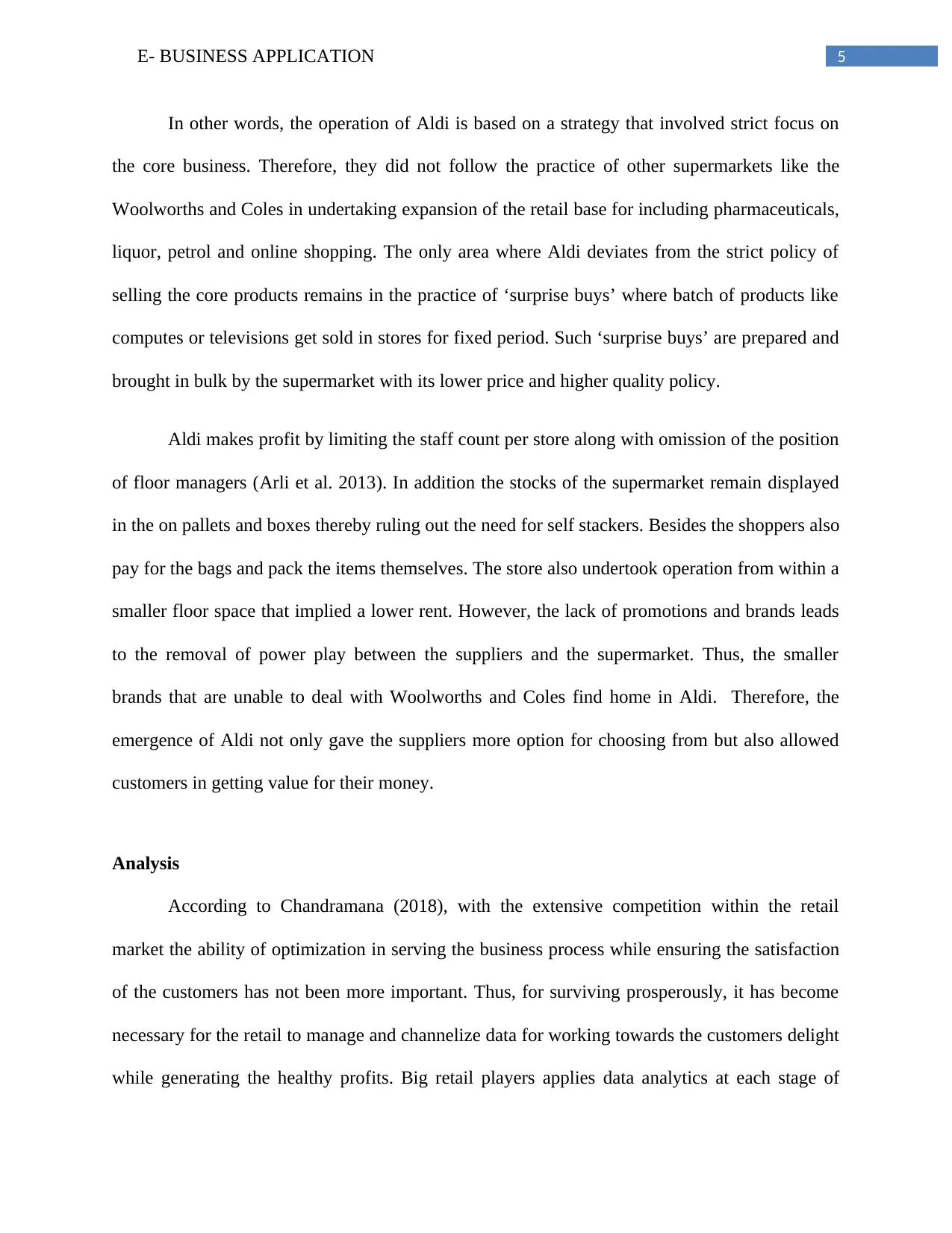
5E- BUSINESS APPLICATION
In other words, the operation of Aldi is based on a strategy that involved strict focus on
the core business. Therefore, they did not follow the practice of other supermarkets like the
Woolworths and Coles in undertaking expansion of the retail base for including pharmaceuticals,
liquor, petrol and online shopping. The only area where Aldi deviates from the strict policy of
selling the core products remains in the practice of ‘surprise buys’ where batch of products like
computes or televisions get sold in stores for fixed period. Such ‘surprise buys’ are prepared and
brought in bulk by the supermarket with its lower price and higher quality policy.
Aldi makes profit by limiting the staff count per store along with omission of the position
of floor managers (Arli et al. 2013). In addition the stocks of the supermarket remain displayed
in the on pallets and boxes thereby ruling out the need for self stackers. Besides the shoppers also
pay for the bags and pack the items themselves. The store also undertook operation from within a
smaller floor space that implied a lower rent. However, the lack of promotions and brands leads
to the removal of power play between the suppliers and the supermarket. Thus, the smaller
brands that are unable to deal with Woolworths and Coles find home in Aldi. Therefore, the
emergence of Aldi not only gave the suppliers more option for choosing from but also allowed
customers in getting value for their money.
Analysis
According to Chandramana (2018), with the extensive competition within the retail
market the ability of optimization in serving the business process while ensuring the satisfaction
of the customers has not been more important. Thus, for surviving prosperously, it has become
necessary for the retail to manage and channelize data for working towards the customers delight
while generating the healthy profits. Big retail players applies data analytics at each stage of
In other words, the operation of Aldi is based on a strategy that involved strict focus on
the core business. Therefore, they did not follow the practice of other supermarkets like the
Woolworths and Coles in undertaking expansion of the retail base for including pharmaceuticals,
liquor, petrol and online shopping. The only area where Aldi deviates from the strict policy of
selling the core products remains in the practice of ‘surprise buys’ where batch of products like
computes or televisions get sold in stores for fixed period. Such ‘surprise buys’ are prepared and
brought in bulk by the supermarket with its lower price and higher quality policy.
Aldi makes profit by limiting the staff count per store along with omission of the position
of floor managers (Arli et al. 2013). In addition the stocks of the supermarket remain displayed
in the on pallets and boxes thereby ruling out the need for self stackers. Besides the shoppers also
pay for the bags and pack the items themselves. The store also undertook operation from within a
smaller floor space that implied a lower rent. However, the lack of promotions and brands leads
to the removal of power play between the suppliers and the supermarket. Thus, the smaller
brands that are unable to deal with Woolworths and Coles find home in Aldi. Therefore, the
emergence of Aldi not only gave the suppliers more option for choosing from but also allowed
customers in getting value for their money.
Analysis
According to Chandramana (2018), with the extensive competition within the retail
market the ability of optimization in serving the business process while ensuring the satisfaction
of the customers has not been more important. Thus, for surviving prosperously, it has become
necessary for the retail to manage and channelize data for working towards the customers delight
while generating the healthy profits. Big retail players applies data analytics at each stage of
⊘ This is a preview!⊘
Do you want full access?
Subscribe today to unlock all pages.

Trusted by 1+ million students worldwide
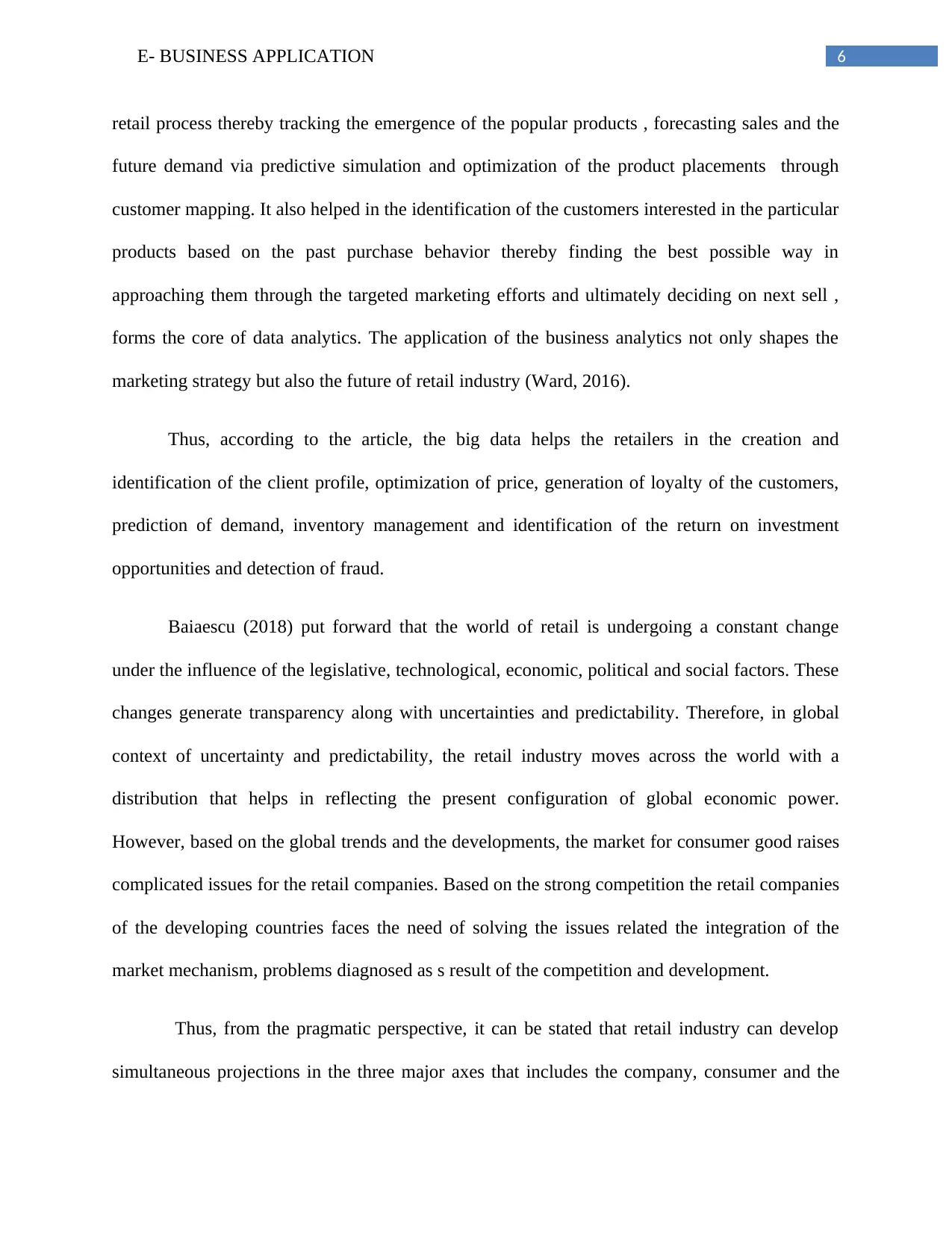
6E- BUSINESS APPLICATION
retail process thereby tracking the emergence of the popular products , forecasting sales and the
future demand via predictive simulation and optimization of the product placements through
customer mapping. It also helped in the identification of the customers interested in the particular
products based on the past purchase behavior thereby finding the best possible way in
approaching them through the targeted marketing efforts and ultimately deciding on next sell ,
forms the core of data analytics. The application of the business analytics not only shapes the
marketing strategy but also the future of retail industry (Ward, 2016).
Thus, according to the article, the big data helps the retailers in the creation and
identification of the client profile, optimization of price, generation of loyalty of the customers,
prediction of demand, inventory management and identification of the return on investment
opportunities and detection of fraud.
Baiaescu (2018) put forward that the world of retail is undergoing a constant change
under the influence of the legislative, technological, economic, political and social factors. These
changes generate transparency along with uncertainties and predictability. Therefore, in global
context of uncertainty and predictability, the retail industry moves across the world with a
distribution that helps in reflecting the present configuration of global economic power.
However, based on the global trends and the developments, the market for consumer good raises
complicated issues for the retail companies. Based on the strong competition the retail companies
of the developing countries faces the need of solving the issues related the integration of the
market mechanism, problems diagnosed as s result of the competition and development.
Thus, from the pragmatic perspective, it can be stated that retail industry can develop
simultaneous projections in the three major axes that includes the company, consumer and the
retail process thereby tracking the emergence of the popular products , forecasting sales and the
future demand via predictive simulation and optimization of the product placements through
customer mapping. It also helped in the identification of the customers interested in the particular
products based on the past purchase behavior thereby finding the best possible way in
approaching them through the targeted marketing efforts and ultimately deciding on next sell ,
forms the core of data analytics. The application of the business analytics not only shapes the
marketing strategy but also the future of retail industry (Ward, 2016).
Thus, according to the article, the big data helps the retailers in the creation and
identification of the client profile, optimization of price, generation of loyalty of the customers,
prediction of demand, inventory management and identification of the return on investment
opportunities and detection of fraud.
Baiaescu (2018) put forward that the world of retail is undergoing a constant change
under the influence of the legislative, technological, economic, political and social factors. These
changes generate transparency along with uncertainties and predictability. Therefore, in global
context of uncertainty and predictability, the retail industry moves across the world with a
distribution that helps in reflecting the present configuration of global economic power.
However, based on the global trends and the developments, the market for consumer good raises
complicated issues for the retail companies. Based on the strong competition the retail companies
of the developing countries faces the need of solving the issues related the integration of the
market mechanism, problems diagnosed as s result of the competition and development.
Thus, from the pragmatic perspective, it can be stated that retail industry can develop
simultaneous projections in the three major axes that includes the company, consumer and the
Paraphrase This Document
Need a fresh take? Get an instant paraphrase of this document with our AI Paraphraser
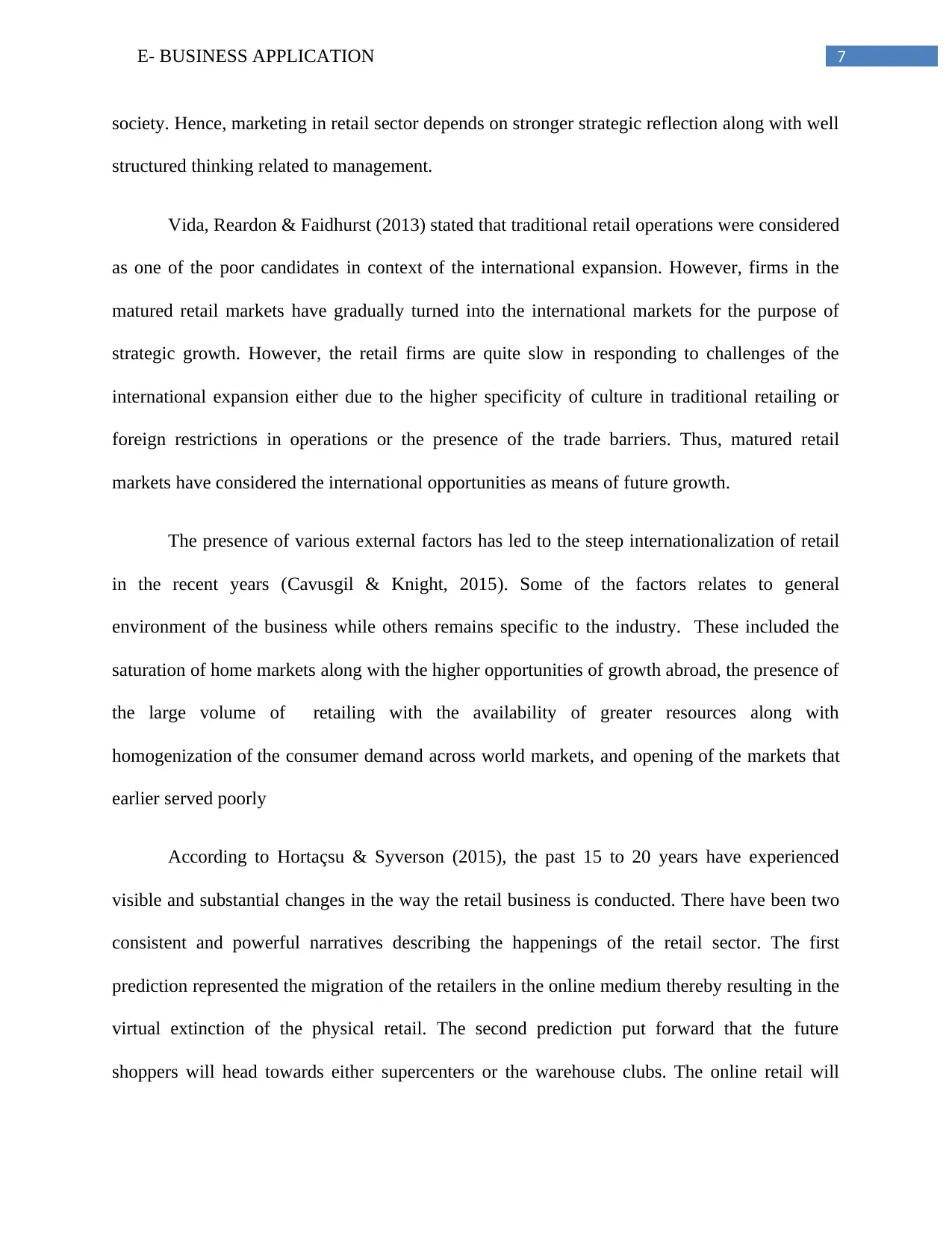
7E- BUSINESS APPLICATION
society. Hence, marketing in retail sector depends on stronger strategic reflection along with well
structured thinking related to management.
Vida, Reardon & Faidhurst (2013) stated that traditional retail operations were considered
as one of the poor candidates in context of the international expansion. However, firms in the
matured retail markets have gradually turned into the international markets for the purpose of
strategic growth. However, the retail firms are quite slow in responding to challenges of the
international expansion either due to the higher specificity of culture in traditional retailing or
foreign restrictions in operations or the presence of the trade barriers. Thus, matured retail
markets have considered the international opportunities as means of future growth.
The presence of various external factors has led to the steep internationalization of retail
in the recent years (Cavusgil & Knight, 2015). Some of the factors relates to general
environment of the business while others remains specific to the industry. These included the
saturation of home markets along with the higher opportunities of growth abroad, the presence of
the large volume of retailing with the availability of greater resources along with
homogenization of the consumer demand across world markets, and opening of the markets that
earlier served poorly
According to Hortaçsu & Syverson (2015), the past 15 to 20 years have experienced
visible and substantial changes in the way the retail business is conducted. There have been two
consistent and powerful narratives describing the happenings of the retail sector. The first
prediction represented the migration of the retailers in the online medium thereby resulting in the
virtual extinction of the physical retail. The second prediction put forward that the future
shoppers will head towards either supercenters or the warehouse clubs. The online retail will
society. Hence, marketing in retail sector depends on stronger strategic reflection along with well
structured thinking related to management.
Vida, Reardon & Faidhurst (2013) stated that traditional retail operations were considered
as one of the poor candidates in context of the international expansion. However, firms in the
matured retail markets have gradually turned into the international markets for the purpose of
strategic growth. However, the retail firms are quite slow in responding to challenges of the
international expansion either due to the higher specificity of culture in traditional retailing or
foreign restrictions in operations or the presence of the trade barriers. Thus, matured retail
markets have considered the international opportunities as means of future growth.
The presence of various external factors has led to the steep internationalization of retail
in the recent years (Cavusgil & Knight, 2015). Some of the factors relates to general
environment of the business while others remains specific to the industry. These included the
saturation of home markets along with the higher opportunities of growth abroad, the presence of
the large volume of retailing with the availability of greater resources along with
homogenization of the consumer demand across world markets, and opening of the markets that
earlier served poorly
According to Hortaçsu & Syverson (2015), the past 15 to 20 years have experienced
visible and substantial changes in the way the retail business is conducted. There have been two
consistent and powerful narratives describing the happenings of the retail sector. The first
prediction represented the migration of the retailers in the online medium thereby resulting in the
virtual extinction of the physical retail. The second prediction put forward that the future
shoppers will head towards either supercenters or the warehouse clubs. The online retail will
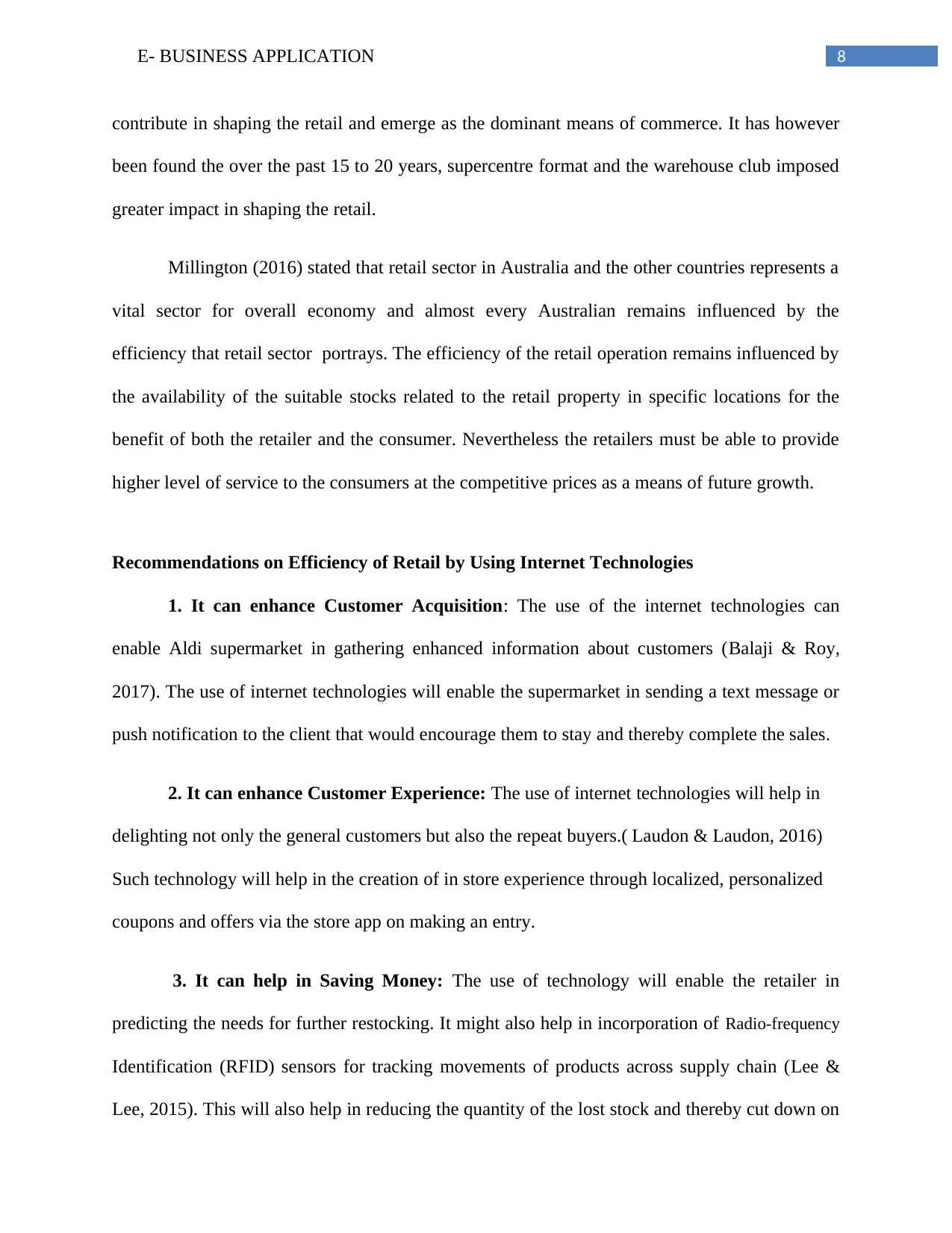
8E- BUSINESS APPLICATION
contribute in shaping the retail and emerge as the dominant means of commerce. It has however
been found the over the past 15 to 20 years, supercentre format and the warehouse club imposed
greater impact in shaping the retail.
Millington (2016) stated that retail sector in Australia and the other countries represents a
vital sector for overall economy and almost every Australian remains influenced by the
efficiency that retail sector portrays. The efficiency of the retail operation remains influenced by
the availability of the suitable stocks related to the retail property in specific locations for the
benefit of both the retailer and the consumer. Nevertheless the retailers must be able to provide
higher level of service to the consumers at the competitive prices as a means of future growth.
Recommendations on Efficiency of Retail by Using Internet Technologies
1. It can enhance Customer Acquisition: The use of the internet technologies can
enable Aldi supermarket in gathering enhanced information about customers (Balaji & Roy,
2017). The use of internet technologies will enable the supermarket in sending a text message or
push notification to the client that would encourage them to stay and thereby complete the sales.
2. It can enhance Customer Experience: The use of internet technologies will help in
delighting not only the general customers but also the repeat buyers.( Laudon & Laudon, 2016)
Such technology will help in the creation of in store experience through localized, personalized
coupons and offers via the store app on making an entry.
3. It can help in Saving Money: The use of technology will enable the retailer in
predicting the needs for further restocking. It might also help in incorporation of Radio-frequency
Identification (RFID) sensors for tracking movements of products across supply chain (Lee &
Lee, 2015). This will also help in reducing the quantity of the lost stock and thereby cut down on
contribute in shaping the retail and emerge as the dominant means of commerce. It has however
been found the over the past 15 to 20 years, supercentre format and the warehouse club imposed
greater impact in shaping the retail.
Millington (2016) stated that retail sector in Australia and the other countries represents a
vital sector for overall economy and almost every Australian remains influenced by the
efficiency that retail sector portrays. The efficiency of the retail operation remains influenced by
the availability of the suitable stocks related to the retail property in specific locations for the
benefit of both the retailer and the consumer. Nevertheless the retailers must be able to provide
higher level of service to the consumers at the competitive prices as a means of future growth.
Recommendations on Efficiency of Retail by Using Internet Technologies
1. It can enhance Customer Acquisition: The use of the internet technologies can
enable Aldi supermarket in gathering enhanced information about customers (Balaji & Roy,
2017). The use of internet technologies will enable the supermarket in sending a text message or
push notification to the client that would encourage them to stay and thereby complete the sales.
2. It can enhance Customer Experience: The use of internet technologies will help in
delighting not only the general customers but also the repeat buyers.( Laudon & Laudon, 2016)
Such technology will help in the creation of in store experience through localized, personalized
coupons and offers via the store app on making an entry.
3. It can help in Saving Money: The use of technology will enable the retailer in
predicting the needs for further restocking. It might also help in incorporation of Radio-frequency
Identification (RFID) sensors for tracking movements of products across supply chain (Lee &
Lee, 2015). This will also help in reducing the quantity of the lost stock and thereby cut down on
⊘ This is a preview!⊘
Do you want full access?
Subscribe today to unlock all pages.

Trusted by 1+ million students worldwide
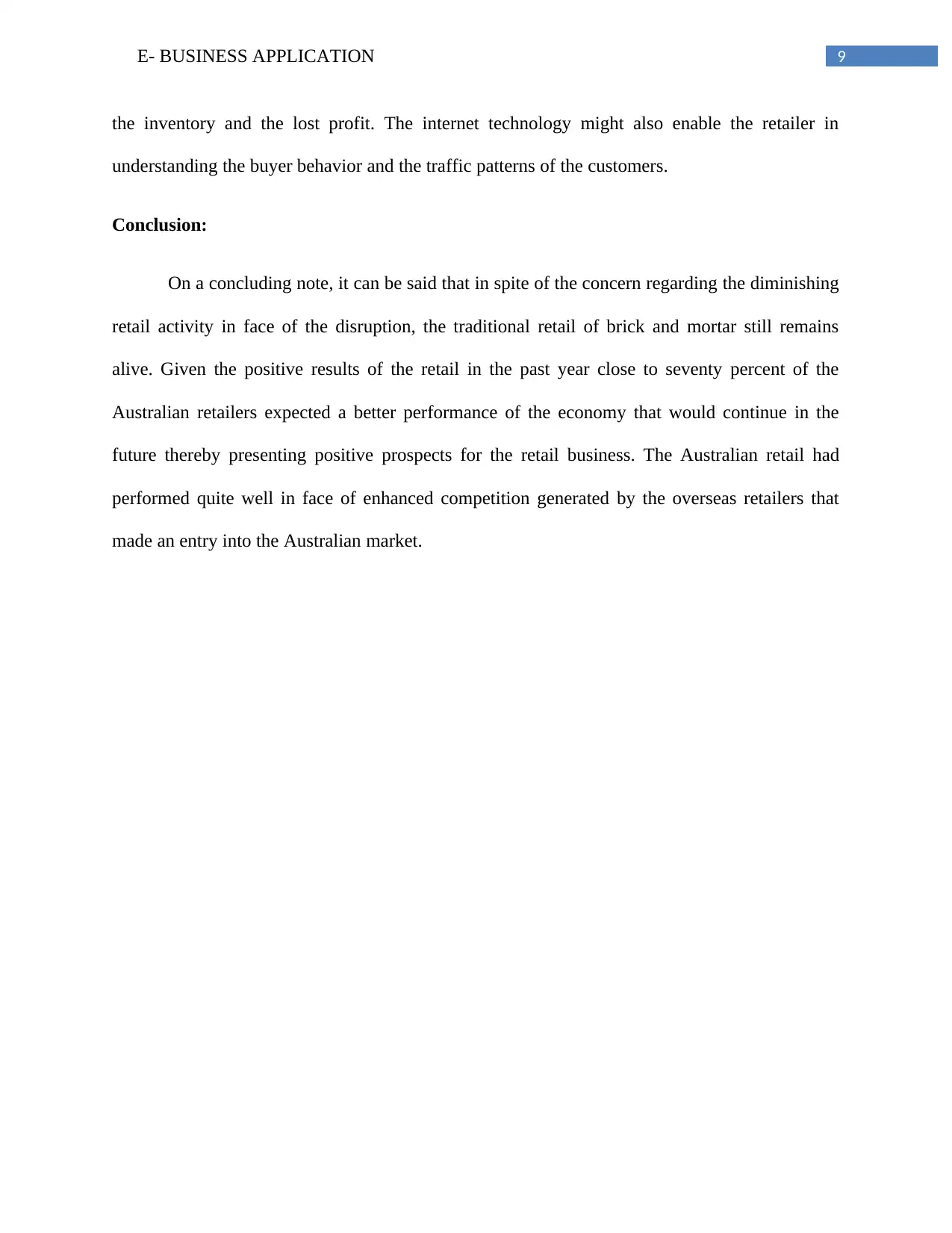
9E- BUSINESS APPLICATION
the inventory and the lost profit. The internet technology might also enable the retailer in
understanding the buyer behavior and the traffic patterns of the customers.
Conclusion:
On a concluding note, it can be said that in spite of the concern regarding the diminishing
retail activity in face of the disruption, the traditional retail of brick and mortar still remains
alive. Given the positive results of the retail in the past year close to seventy percent of the
Australian retailers expected a better performance of the economy that would continue in the
future thereby presenting positive prospects for the retail business. The Australian retail had
performed quite well in face of enhanced competition generated by the overseas retailers that
made an entry into the Australian market.
the inventory and the lost profit. The internet technology might also enable the retailer in
understanding the buyer behavior and the traffic patterns of the customers.
Conclusion:
On a concluding note, it can be said that in spite of the concern regarding the diminishing
retail activity in face of the disruption, the traditional retail of brick and mortar still remains
alive. Given the positive results of the retail in the past year close to seventy percent of the
Australian retailers expected a better performance of the economy that would continue in the
future thereby presenting positive prospects for the retail business. The Australian retail had
performed quite well in face of enhanced competition generated by the overseas retailers that
made an entry into the Australian market.
Paraphrase This Document
Need a fresh take? Get an instant paraphrase of this document with our AI Paraphraser
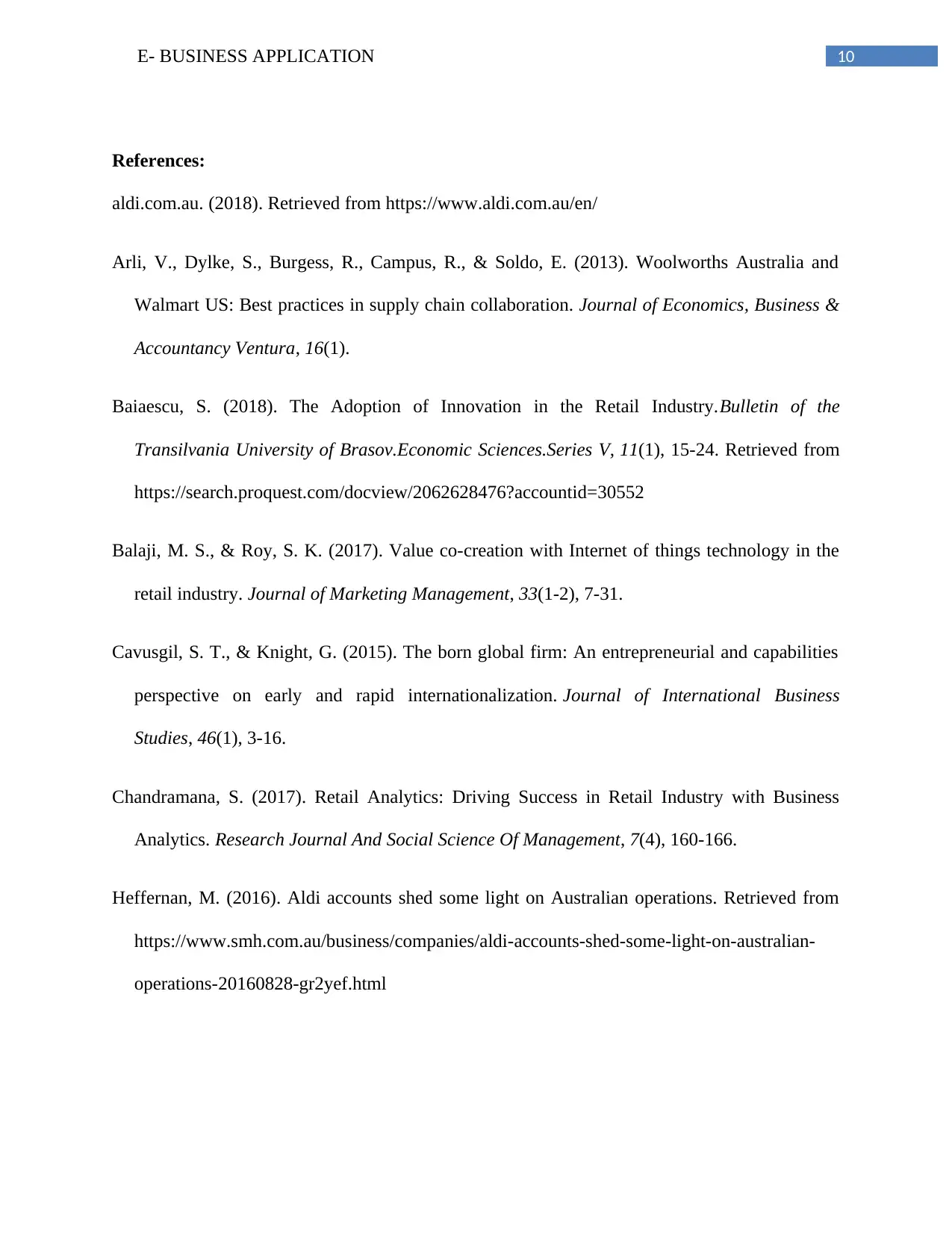
10E- BUSINESS APPLICATION
References:
aldi.com.au. (2018). Retrieved from https://www.aldi.com.au/en/
Arli, V., Dylke, S., Burgess, R., Campus, R., & Soldo, E. (2013). Woolworths Australia and
Walmart US: Best practices in supply chain collaboration. Journal of Economics, Business &
Accountancy Ventura, 16(1).
Baiaescu, S. (2018). The Adoption of Innovation in the Retail Industry.Bulletin of the
Transilvania University of Brasov.Economic Sciences.Series V, 11(1), 15-24. Retrieved from
https://search.proquest.com/docview/2062628476?accountid=30552
Balaji, M. S., & Roy, S. K. (2017). Value co-creation with Internet of things technology in the
retail industry. Journal of Marketing Management, 33(1-2), 7-31.
Cavusgil, S. T., & Knight, G. (2015). The born global firm: An entrepreneurial and capabilities
perspective on early and rapid internationalization. Journal of International Business
Studies, 46(1), 3-16.
Chandramana, S. (2017). Retail Analytics: Driving Success in Retail Industry with Business
Analytics. Research Journal And Social Science Of Management, 7(4), 160-166.
Heffernan, M. (2016). Aldi accounts shed some light on Australian operations. Retrieved from
https://www.smh.com.au/business/companies/aldi-accounts-shed-some-light-on-australian-
operations-20160828-gr2yef.html
References:
aldi.com.au. (2018). Retrieved from https://www.aldi.com.au/en/
Arli, V., Dylke, S., Burgess, R., Campus, R., & Soldo, E. (2013). Woolworths Australia and
Walmart US: Best practices in supply chain collaboration. Journal of Economics, Business &
Accountancy Ventura, 16(1).
Baiaescu, S. (2018). The Adoption of Innovation in the Retail Industry.Bulletin of the
Transilvania University of Brasov.Economic Sciences.Series V, 11(1), 15-24. Retrieved from
https://search.proquest.com/docview/2062628476?accountid=30552
Balaji, M. S., & Roy, S. K. (2017). Value co-creation with Internet of things technology in the
retail industry. Journal of Marketing Management, 33(1-2), 7-31.
Cavusgil, S. T., & Knight, G. (2015). The born global firm: An entrepreneurial and capabilities
perspective on early and rapid internationalization. Journal of International Business
Studies, 46(1), 3-16.
Chandramana, S. (2017). Retail Analytics: Driving Success in Retail Industry with Business
Analytics. Research Journal And Social Science Of Management, 7(4), 160-166.
Heffernan, M. (2016). Aldi accounts shed some light on Australian operations. Retrieved from
https://www.smh.com.au/business/companies/aldi-accounts-shed-some-light-on-australian-
operations-20160828-gr2yef.html
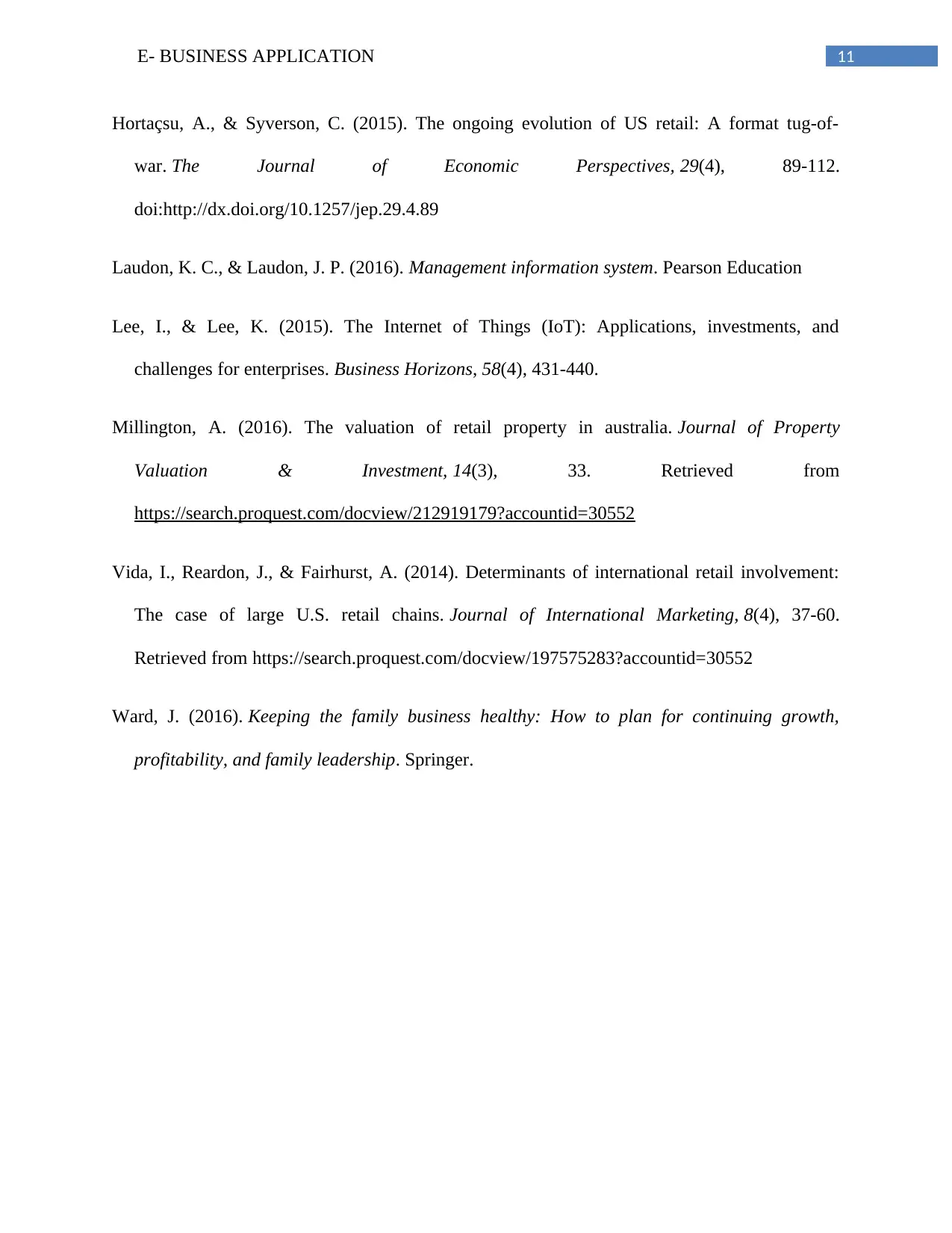
11E- BUSINESS APPLICATION
Hortaçsu, A., & Syverson, C. (2015). The ongoing evolution of US retail: A format tug-of-
war. The Journal of Economic Perspectives, 29(4), 89-112.
doi:http://dx.doi.org/10.1257/jep.29.4.89
Laudon, K. C., & Laudon, J. P. (2016). Management information system. Pearson Education
Lee, I., & Lee, K. (2015). The Internet of Things (IoT): Applications, investments, and
challenges for enterprises. Business Horizons, 58(4), 431-440.
Millington, A. (2016). The valuation of retail property in australia. Journal of Property
Valuation & Investment, 14(3), 33. Retrieved from
https://search.proquest.com/docview/212919179?accountid=30552
Vida, I., Reardon, J., & Fairhurst, A. (2014). Determinants of international retail involvement:
The case of large U.S. retail chains. Journal of International Marketing, 8(4), 37-60.
Retrieved from https://search.proquest.com/docview/197575283?accountid=30552
Ward, J. (2016). Keeping the family business healthy: How to plan for continuing growth,
profitability, and family leadership. Springer.
Hortaçsu, A., & Syverson, C. (2015). The ongoing evolution of US retail: A format tug-of-
war. The Journal of Economic Perspectives, 29(4), 89-112.
doi:http://dx.doi.org/10.1257/jep.29.4.89
Laudon, K. C., & Laudon, J. P. (2016). Management information system. Pearson Education
Lee, I., & Lee, K. (2015). The Internet of Things (IoT): Applications, investments, and
challenges for enterprises. Business Horizons, 58(4), 431-440.
Millington, A. (2016). The valuation of retail property in australia. Journal of Property
Valuation & Investment, 14(3), 33. Retrieved from
https://search.proquest.com/docview/212919179?accountid=30552
Vida, I., Reardon, J., & Fairhurst, A. (2014). Determinants of international retail involvement:
The case of large U.S. retail chains. Journal of International Marketing, 8(4), 37-60.
Retrieved from https://search.proquest.com/docview/197575283?accountid=30552
Ward, J. (2016). Keeping the family business healthy: How to plan for continuing growth,
profitability, and family leadership. Springer.
⊘ This is a preview!⊘
Do you want full access?
Subscribe today to unlock all pages.

Trusted by 1+ million students worldwide
1 out of 13
Related Documents
Your All-in-One AI-Powered Toolkit for Academic Success.
+13062052269
info@desklib.com
Available 24*7 on WhatsApp / Email
![[object Object]](/_next/static/media/star-bottom.7253800d.svg)
Unlock your academic potential
Copyright © 2020–2025 A2Z Services. All Rights Reserved. Developed and managed by ZUCOL.





